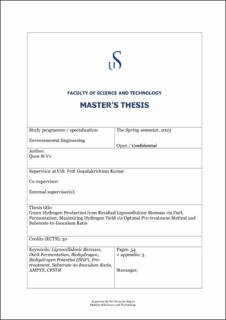Green Hydrogen Production from Residual Lignocellulosic Biomass via Dark Fermentation: Maximizing Hydrogen Yield via Optimal Pretreatment Method and Substrate-to-Inoculum Ratio
Master thesis
Permanent lenke
https://hdl.handle.net/11250/3105151Utgivelsesdato
2023Metadata
Vis full innførselSamlinger
Sammendrag
This thesis presents an investigation into the biohydrogen production potential of Lignocellulosic Aquatic Residue (LAR), a byproduct of an industrial process. A detailed examination of the substrate and inoculum characterization, pretreatment methods, biohydrogen production via dark fermentation at different Substrate-to-Inoculum Ratios (SIRs), and kinetics modelling was conducted. The study aims to illustrate that LAR can serve as an effective substrate for renewable biohydrogen production via dark fermentation.
After mild acid hydrolysis and lipid extraction pretreatment, LAR showed a high carbohydrate and lipid content. However, the pretreatment process needs to be optimized to avoid the introduction or release of inhibitory compounds since no gas production was observed from those pretreated LAR. Further examination revealed an optimal SIR of 2.7, where Hydrogen Yield (HY) of LAR reached around 280 mL H2 g −1 VS.
A Continuous Flow Stirred-Tank Reactor (CFSTR) was built to upscale the biohydrogen production, which produced promising preliminary results. Energy output estimation indicated that biohydrogen production from LAR could contribute between 2.6 to 3.5 TWh per year, equating to 1.2 to 1.6 % of Norway’s total energy demand. This approach turns an otherwise waste product into a source of renewable energy.
These findings suggest that the utilization of LAR for biohydrogen production via dark fermentation holds significant potential for future green energy solutions. Continued research is necessary to optimize pretreatment methods, operational conditions, and to fully understand this unique biomass resource.
Beskrivelse
Master's thesis in Environmental engineering
